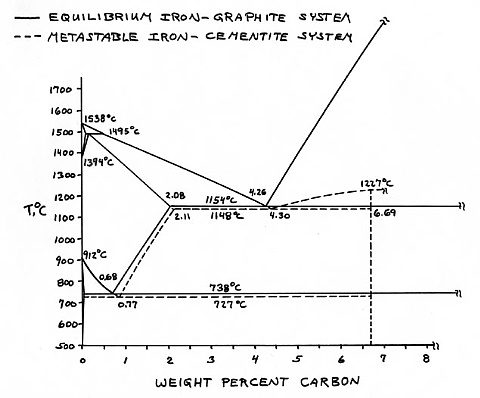|
INTRODUCTION
- Lesson 1 - Cast Irons
The first lesson concentrates on the
metallurgical
microstructures of cast irons. The photomicrographs that I made
of these microstructures show the sensitivity
of microstructure to the processing and environmental history of each
macrosopic
specimen in the M.I.T. specimen collection. Be sure you pay
particular attention to the concepts of
stability and metastability as they are applied to the iron - carbon
phase diagram. Various alloying elements, the cooling rates
during solidification, and the time of heat treatment all critically
control whether the specimen follows the stable iron -
graphite or the metastable iron -
cementite phase diagram.
|
 The image at left shows both systems
together. The stable iron - carbon equilibrium diagram has solid
lines, whereas the metastable iron - cementite system is represented by
dotted lines. Note that the austenite
<=> liquid, delta
ferrite <=>
liquid, and austenite
<=> alpha ferrite equilibria are unaffected by the
stability of the carbon-rich phase (whether graphite or
cementite). The stable temperature range of the more stable phase
always extends to a higher temperature. Thus, cementite melts at
a lower temperature than graphite, and both the eutectic temperature
and the eutectoid
temperature of the iron - cementite system are lower than those of the
iron - graphite system. The image at left shows both systems
together. The stable iron - carbon equilibrium diagram has solid
lines, whereas the metastable iron - cementite system is represented by
dotted lines. Note that the austenite
<=> liquid, delta
ferrite <=>
liquid, and austenite
<=> alpha ferrite equilibria are unaffected by the
stability of the carbon-rich phase (whether graphite or
cementite). The stable temperature range of the more stable phase
always extends to a higher temperature. Thus, cementite melts at
a lower temperature than graphite, and both the eutectic temperature
and the eutectoid
temperature of the iron - cementite system are lower than those of the
iron - graphite system.
Silicon and nickel both destabilize cementite and promote
graphitization, so castings made with sufficient amounts of either
element are more likely to freeze to austenite plus graphite than to
austenite plus cementite.
|
Allow plenty of
time to study and to take good notes about each specimen. About
two hours per lesson would be appropriate. You will be expected
to interpret some of these specimens during the final
examination. Feel free to use the Internet to find additional
information about the alloys and applications mentioned here.
|
Whenever the
narrator asks a question, be sure to commit yourself to an answer
before going to the next page. You can backtrack with your
browser's BACK button at any time, of course. Just be sure to click
the FORWARD button to return to the proper page before proceeding so
that you don't get lost.
|
FIRST
SPECIMEN
|